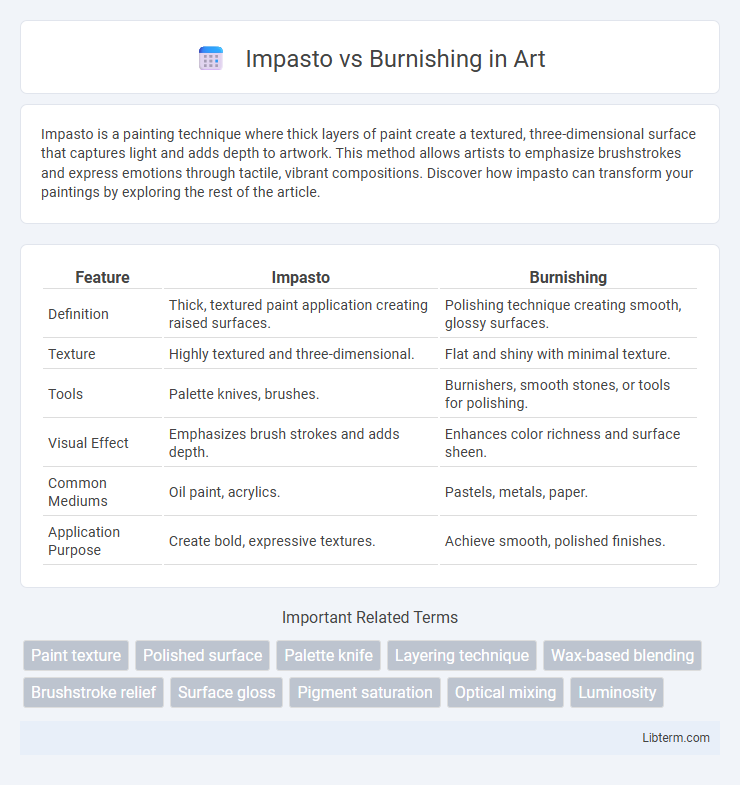Impasto is a painting technique where thick layers of paint create a textured, three-dimensional surface that captures light and adds depth to artwork. This method allows artists to emphasize brushstrokes and express emotions through tactile, vibrant compositions. Discover how impasto can transform your paintings by exploring the rest of the article.
Table of Comparison
| Feature | Impasto | Burnishing |
|---|---|---|
| Definition | Thick, textured paint application creating raised surfaces. | Polishing technique creating smooth, glossy surfaces. |
| Texture | Highly textured and three-dimensional. | Flat and shiny with minimal texture. |
| Tools | Palette knives, brushes. | Burnishers, smooth stones, or tools for polishing. |
| Visual Effect | Emphasizes brush strokes and adds depth. | Enhances color richness and surface sheen. |
| Common Mediums | Oil paint, acrylics. | Pastels, metals, paper. |
| Application Purpose | Create bold, expressive textures. | Achieve smooth, polished finishes. |
Introduction to Impasto and Burnishing
Impasto is a painting technique characterized by thick layers of paint applied with brushes or palette knives, creating texture that stands out from the canvas surface and adds dimensionality to artworks. Burnishing, often used in printmaking and leatherwork, involves rubbing a surface to create a smooth, polished finish by compressing the material and enhancing its sheen. Both techniques manipulate surface texture to achieve distinct visual effects, with impasto emphasizing tactile strokes and burnishing focusing on smooth, reflective quality.
Defining Impasto Technique
Impasto is a painting technique characterized by the application of thick layers of paint, often acrylic or oil, which create texture and depth on the canvas. This method highlights brush or palette knife strokes, allowing light to catch the ridges and produce dynamic visual effects. Unlike burnishing, which smooths and polishes surfaces, impasto emphasizes tactile, three-dimensional qualities in artwork.
Understanding Burnishing Technique
Burnishing technique involves polishing the surface of a painted or sculpted artwork using a smooth, hard tool to create a glossy, reflective finish that enhances color depth and texture detail. Unlike impasto, which emphasizes thick paint applications and tactile texture, burnishing smooths pigments or metal surfaces to achieve a sleek, luminous effect often seen in printmaking and metalwork. Mastery of burnishing requires precise pressure control and tool selection to avoid damaging the substrate while maximizing the visual richness.
Key Differences Between Impasto and Burnishing
Impasto is a painting technique characterized by applying thick layers of paint to create texture and dimensionality, often visible as raised brush strokes or knife marks on the canvas. Burnishing, on the other hand, is a printmaking or metalworking process that involves polishing a surface to create a smooth, shiny finish by rubbing or pressing to compress fibers or materials. The key difference lies in the tactile outcome: impasto emphasizes texture and volume, while burnishing prioritizes smoothness and sheen.
Materials and Tools Required
Impasto painting requires thick applications of oil or acrylic paints, often applied with stiff brushes, palette knives, or even spatulas to create textured, three-dimensional effects. Burnishing involves smooth, polished surfaces typically achieved with graphite, colored pencils, or metal tools like agate burnishers on paper, leather, or metal. The choice of materials directly affects the final artistic texture: impasto emphasizes volume and depth, while burnishing enhances smoothness and subtle sheen.
Suitable Art Mediums for Each Technique
Impasto technique is best suited for thick oil and acrylic paints, which retain texture and volume, allowing artists to create raised, tactile surfaces. Burnishing works effectively with colored pencils, graphite, and pastels, where friction smooths and blends pigment particles to produce a polished, glossy finish. Each method leverages the physical properties of specific mediums to achieve distinct visual and textural effects.
Visual Effects Achieved with Impasto
Impasto creates a textured, three-dimensional surface by applying thick layers of paint, enhancing light reflection and adding dynamic depth to artwork. This technique intensifies color vibrancy and emphasizes brushstrokes or palette knife marks, producing bold, tactile visual effects. Unlike burnishing, which smooths and polishes surfaces for subtle shine, impasto highlights expressive, raised textures that engage viewers through pronounced physicality.
Visual Effects Achieved with Burnishing
Burnishing creates a polished, glossy surface by compressing and smoothing the paint, resulting in intensified color depth and a luminous, jewel-like finish that contrasts with the thick, textured effects of impasto. This technique enhances highlights and reflections, giving artwork a sleek, refined appearance that draws the viewer's eye to subtle details. The visual effect of burnishing emphasizes surface brilliance and clarity, making colors appear richer and light interaction more dynamic than the tactile prominence seen in impasto.
Common Mistakes and How to Avoid Them
Common mistakes in impasto include overloading the brush, which causes uneven texture, and failing to properly prepare the canvas, resulting in poor paint adhesion. In burnishing, excessive pressure can damage delicate paper fibers or create unwanted shine, so using light, even strokes is crucial. To avoid these issues, artists should practice controlled application techniques and choose appropriate tools and surfaces tailored to each method.
Choosing the Right Technique for Your Artwork
Impasto involves applying thick layers of paint to create textured, three-dimensional surfaces that emphasize brushstrokes and add dramatic depth to artwork. Burnishing smooths and polishes the surface, enhancing color richness and producing a glossy, refined finish ideal for detailed or delicate effects. Choosing between impasto and burnishing depends on the desired visual impact, medium used, and the tactile qualities you want to highlight in your artwork.
Impasto Infographic

 libterm.com
libterm.com